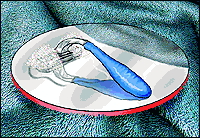Shaving Your Patient's Face
Created | Updated Feb 23, 2012

When someone is placed in a health care facility (eg hospital, nursing home or rehab facility) it involves more than just diagnostic testing and medical treatment. The basic, fundamental needs of a person must be met on a daily basis. These essential needs are termed activities of daily living (eg grooming, shaving or bathing).
Patients that cannot fulfil these needs on their own need to be assisted. Bathing is of course a must. While bathing removes much of the daily accumulated dirt and bacteria from the skin, there are additional benefits to shaving the face. Particles can remain on a person's hair follicles: shaving will remedy this and, by removing hair, the surface area on which bacteria can accumulate will reduce. Shaving can also give the patient a better feeling of his/her personal appearance and studies have shown that feeling good about themselves causes patients to recover more quickly.
How To
Before beginning you will need a few supplies such as:
- Two dry bath towels
- Two wash cloths
- One new, unused razor (health care facilities tend to rely on disposable razors)
- One can of shaving cream
- One basin
- One bottle of moisturising lotion
- One bottle of aftershave (optional, but if you are going to use it, it should be of the patient's choosing)
Begin by placing your patient in a sitting position and support their back.
Fill the basin with warm water (about 40-41°C) approximately half way. Add 30cc of the moisturising lotion to your water. Place the basin of lotion and water on the bedside table. Soak your wash cloths in the warm water. Place one of your towels over the patient's chest. Take one of the wash cloths from the water and soak your patient's face. This will open the pores and soften the beard. Apply a generous amount of shaving cream over the area that is to be shaven. Use care in the application of the shaving cream to avoid contact with the patient's eyes and mouth.
Use a new razor for each shave to ensue proper sharpness of the blades and to prevent cross infection from other patients. You may begin at any point, but it is easier to work from left to right or from right to left, starting from the base of the desired side burns, just in front of the ear. When shaving your patient shave in a lateral or descending motion. In some instances it is necessary to shave in an ascending motion. In this case it pertinent for you to use extreme caution. The more experience you have in shaving will dictate when it is appropriate to use an ascending motion versus a lateral or descending motion.
If your patient has wrinkles it is necessary to straighten the wrinkled skin out as much as possible with your free hand. Use care when doing this to avoid pinching your patient.
The type of medication that your patient is on is also a factor that must be taken into consideration. If you have a patient who is on anticoagulants (such as heparin or coumadin) you may want to opt for the electric razor, because on these patients if you break the skin while shaving it will take longer to stop bleeding.
The one-on-one time that occurs when you shave someone's face will help you to build a bond of trust and confidence with your patient. You can also enable your patient to feel better about their outward appearance and make their stay much more comfortable.

